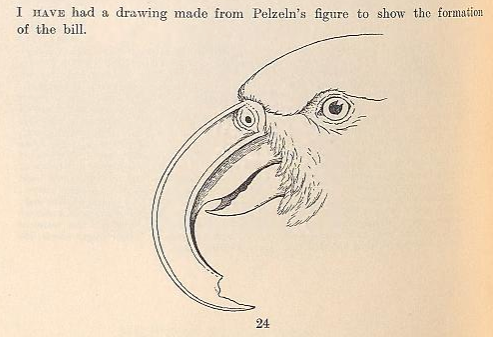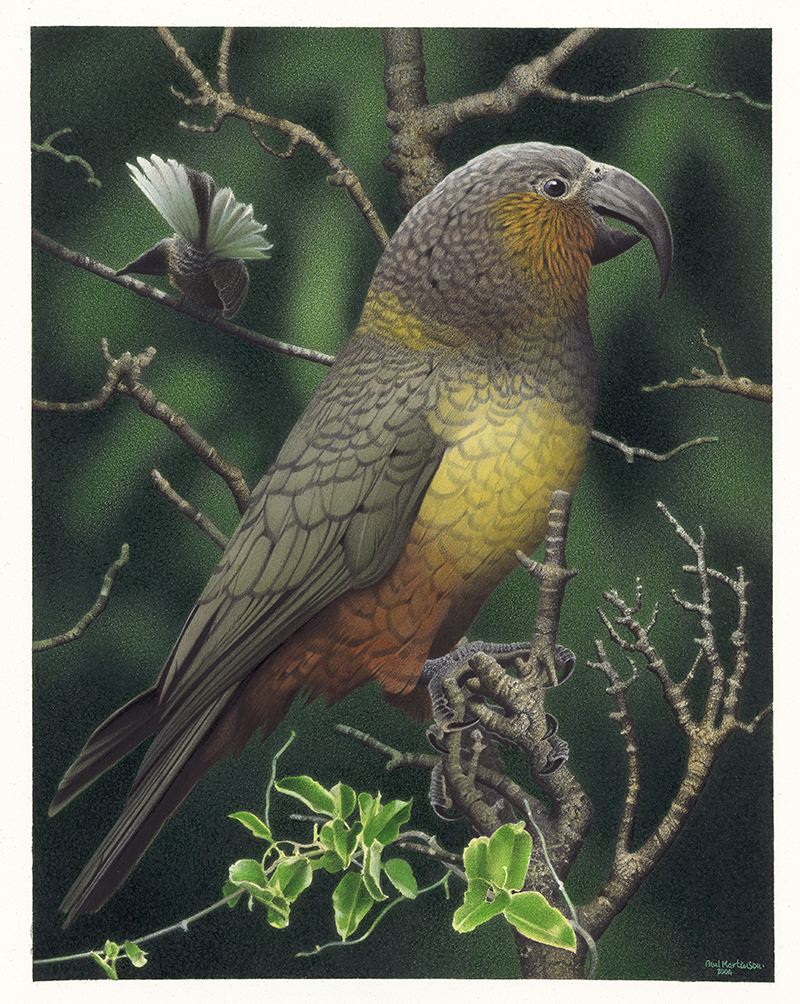Nestor productus (Gould, 1836:19)
Norfolk Island kaka, Norfolk Island parrot (used by Day, 1981:81), Wilson's parrakeet (archaic), Long-billed parrot (archaic; used by Mathews, 1928:23, pl. 15)
Taxonomy & Nomenclature
A complete synonymy taken from (Checklist Committee (OSNZ), 2010:251):
Plyctolophus productus Gould, 1836: Proc. Zool. Soc. London 1836 (4): 19 – no locality = Philip Island, off Norfolk Island (fide Mathews 1928, Birds Norfolk & Lord Howe Islands: 23).; Centrurus productus (Gould); Bonaparte 1856, Naumannia: no 235.; Nestor norfolcensis Pelzeln, 1860: Sitzungsber. K. Akad. Wissen., Math.-Naturwissen. Cl., Wien 41: 322, fig. 1 – Norfolk Island.; Nestor productus (Gould); G.R. Gray, 1862: Ibis 4: 230.; Nestor hypopolius; Iredale 1937, Emu 37: 99. Not Psittacus hypopolius J.R. Forster, 1794.; Nestor meridionalis productus (Gould, 1836:19)
Conservation Status
Extinct (WCMC, 1992:211)
Last record: 1830's (Kittelberger et al., 2024); 1851 (Forshaw, 1981; WCMC, 1992:211); after 1851 (Day, 1981:82); early 1850's (Hume & Walters, 2012:166)
IUCN RedList status: Extinct
Distribution
Norfolk Island & Phillip Island
Biology & Ecology
Hypodigm
At least 15 preserved specimens still exist, but possibly more. The last known specimen died in captivity in London, in 1851 (Forshaw, 1981) or after (Day, 1981:82).
[url=http://nlbif.eti.uva.nl/naturalis/detail.php?lang=uk&id=51]RMNH 110.061[/url] (adult, male)
[url=http://nlbif.eti.uva.nl/naturalis/detail.php?lang=uk&id=51]RMNH 110.068[/url] (adult, female)
Media

Above: illustration from Mathews (1928).

Above: illustration from Mathews (1928:24).

Above: Norfolk Island Kaka. Nestor productus. From the series: Extinct Birds of New Zealand., 2004, Masterton, by Paul Martinson. Purchased 2006. © Te Papa. CC BY-NC-ND 4.0. Te Papa (2006-0010-1/56)
References
Original scientific description:
Gould, John. (1836). Characters of some new Birds in the Society's Collection, including two new genera, [i]Paradoxornis[/i] and [i]Actinodura[/i]. [i]In[/i] Proceedings of meeting of Zoological Society of London, Feb. 23, 1836. Proceedings of the Zoological Society of London 38(4): 17-19.
Other references:
BirdLife International. (2012). Nestor productus. In: IUCN 2012. IUCN Red List of Threatened Species. Version 2012.1. (http://www.iucnredlist.org). Downloaded on 01 September 2012.
BirdLife International. 2016. Nestor productus. The IUCN Red List of Threatened Species 2016: e.T22684834A93049105. https://dx.doi.org/10.2305/IUCN.UK.2016-3.RLTS.T22684834A93049105.en. Accessed on 18 June 2022.
Brooks, T. 2000. Extinct species. In: BirdLife International (ed.), Threatened Birds of the World, pp. 701-708. Lynx Edicions and BirdLife International, Barcelona and Cambridge, U.K.
Checklist Committee (OSNZ). (2010). Checklist of the Birds of New Zealand, Norfolk and Macquarie Islands, and the Ross Dependency, Antarctica (4th ed.). Ornithological Society of New Zealand & Te Papa Press, Wellington. [p. 251]
Christian, Margaret. (2005). Norfolk Island: The Birds. Norfolk Island: Green Eyes Publications. [relevant citation?]
Christidis, L. and Boles, W.E. 2008. Systematics and Taxonomy of Australian Birds. CSIRO Publishing, Collingwood, Australia.
Day, David. (1981). The Doomsday Book of Animals: A Natural History of Vanished Species. New York, N.Y.: The Viking Press.
Feldegg C. F. von 1842: Catalog der Exotischen Voegel in der Sammlung des Obersten Baron Feldegg zusammengestellt am 31 October 1842. Unpublished manuscript, deposited in the Department of Zoology, National Museum, Prague, Czech Republic.
Forbes, H.O. & Robinson, H.C. 1897. Catalogue of the parrots (Psittaci) in the Derby Museum. Bulletin of the Liverpool Museum 1: 5–22
Forshaw, Joseph M. (1969). Australian Parrots. Melbourne: Lansdowne Press. [first edition]
Forshaw, J.M. 1978. Parrots of the World. 2nd (revised) Edn. Illustrated by W.T. Cooper. Melbourne : Lansdowne Edns 616 pp. 158 pls.
Forshaw, Joseph M. (1981). Australian Parrots, second edition. Melbourne: Lansdowne Press.
Forshaw, Joseph M. and Knight, Frank. (2017). Vanished and Vanishing Parrots: Profiling Extinct and Endangered Species. Melbourne: CSIRO Publishing.
Forster, J. R. (1844). In: Lichtenstein, Heinrich (ed.). Descriptiones animalium quae in itinere ad Maris australis terras per annos 1772, 1773 et 1774 suscepto collegit, observavit et delineavit Ioannes Reinoldus Forster. Berlin.
Garnett, Stephen (ed.). (1992). Threatened and Extinct Birds of Australia. RAOU Report Number 82. 212 pp.
Garnett, S. T. and Crowley, G. M. (2000). The Action Plan for Australian Birds 2000. Canberra, ACT: Environment Australia & Birds Australia.
Garnett, S. T.; Szabo, J. K.; Dutson, G. 2011. The Action Plan for Australian Birds 2010. CSIRO Publishing, Collingwood.
Gould, John. (1838). A Synopsis of the Birds of Australia, and the Adjacent Islands. London : J. Gould 73 pls 8 pp.
Gould, J. 1848. The Birds of Australia. London : J. Gould Vol. 5 92 pls. (published September 1841?)
Gould, John. (1865). Handbook to the Birds of Australia. Vol. 2. J. Gould, London. 629 pp.
Greenway, J. C. (1967). Extinct and Vanishing Birds of the World. New York: Dover Publications.
Gurney, J. H. (1854). Note on Nestor productus, the extinct parrot of Philip Island. Zoologist 12: 4298.
Higgins, P.J. (Ed.). 1999. Handbook of Australian, New Zealand & Antarctic birds. Parrots to dollarbird. Volume 4. Melbourne: Oxford University Press. 1248 pp.
Holdaway, Richard N. and Anderson, Atholl. (2001). Avifauna from the Emily Bay settlement site, Norfolk Island: A preliminary account, pp. 85-100. In: Anderson, Atholl and White, Peter (eds.). Records of the Australian Museum, Supplement 27. Sydney: Australian Museum.
Holdaway, Richard N., Worthy, Trevor H. and Tennyson, Alan J. D. (2001). A working list of breeding bird species of the New Zealand region at first human contact. New Zealand Journal of Zoology 28: 119-187.
del Hoyo, J., Collar, N.J., Christie, D.A., Elliott, A. and Fishpool, L.D.C. 2014. HBW and BirdLife International Illustrated Checklist of the Birds of the World. Volume 1: Non-passerines. Lynx Edicions BirdLife International, Barcelona, Spain and Cambridge, UK.
Hull, Arthur Francis Basset. (1909). The birds of Lord Howe and Norfolk Islands. Proceedings of the Linnean Society of New South Wales 34: 636-693, pls. l-liv. [p. 675]
Hume, Julian Pender and Walters, Michael. (2012). Extinct birds. London: T & AD Poyser. 544 pp.
Kittelberger, Kyle D., Tanner, Colby J., Buxton, Amy N., Prewett, Amira and Şekercioğlu, Çağan Hakkı. (2024). Correlates of avian extinction timing around the world since 1500 CE. Avian Research 15: 100213. https://doi.org/10.1016/j.avrs.2024.100213 [Supplementary data (List of 216 taxa)]
Knox, Alan G. and Walters, Michael P. (1994). Extinct and endangered birds in the collections of The Natural History Museum. British Ornithologists' Club Occasional Publications 1: 1-292. [p. 146]
Mathews, G.M. 1925. The Birds of Australia. Supplements 4 & 5. Bibliography of the Birds of Australia Pts 1 & 2. London : H.F. & G. Witherby viii 149 pp.
Mathews, Gregory Macalister. (1928). The Birds of Norfolk & Lord Howe Islands and the Australasian South Polar Quadrant: with additions to "birds of Australia". London: H.F. & G. Witherby. xii + 139 pp, pls 1-45. [p. 23-24, pl. 15]
Mlíkovský, Jiří. (2012). Extinct and nearly extinct birds in the collections of the National Museum, Prague, Czech Republic. Journal of the National Museum (Prague), Natural History Series 181(9): 95-123. [automatic download]
Moore, James L. (1985). Ensign Best's bird observations on Norfolk Island. Notornis 32: 319-322.
Morton, Steve, Sheppard, Andy and Lonsdale, Mark (eds.). (2014). Biodiversity: Science and Solutions for Australia (CSIRO Science and Solutions for Australia Series). Collingwood, VIC: CSIRO Publishing. v + 226 pp.
Pelzeln, A. v. (1860). Zur Ornithologie der Insel Norfolk. Sitzungberichte der Academie der Wissenschaften Mathematisch-Naturwissenschaftliche Classe, Wien 41: 319-332.
Peters, J.L. 1937. Check-list of Birds of the World. Cambridge : Harvard University Press Vol. 3 xiii 311 pp. [143]
Rothschild, Lionel Walter. (1907). Extinct birds: an attempt to write in one volume a short account of those birds which have become extinct in historical times, that is within the last six or seven hundred years: to which are added a few which still exist, but are on the verge of extinction. London: Hutchinson & Co. XXIX + 243 pp. [p. 45-46, pl. 6 (as productus); p. 47, pl. 6 (as norfolcensis)]
Salvadori, T. 1891. Catalogue of the Birds in the British Museum. Catalogue of the Psittaci, or Parrots. London : British Museum Vol. 20 xvii 658 pp. XVIII pls.
Sayol, Ferran, Steinbauer, Manuel J., Blackburn, Tim M., Antonelli, Alexandre and Faurby, Søren. (2020). Anthropogenic extinctions conceal widespread evolution of flightlessness in birds. Science Advances 6(49): eabb6095. https://doi.org/10.1126/sciadv.abb6095 [Supplementary Material (Data File S1)]
Schodde R, Fullagar R, and Hermes N (1983) A Review of Norfolk Island Birds: Past and Present. Special Publication 8. Australian National Parks and Wildlife Service, Canberra.
Sharpe, R.B. 1906. Birds. pp. 79–515 in, The History of the Collections contained in the Natural History Departments of the British Museum. London : British Museum Vol. 2. (514–515).
Sibley, C.G. & Monroe, B.L., Jr 1990. Distribution and Taxonomy of Birds of the World. New Haven : Yale University Press xxiv 1111 pp.
Stone, W. & Mathews, G.M. 1913. Additional species described by Gould from Norfolk, Lord Howe, and Philip Islands. Austral Avian Records 1: 182-183.
Tristram, H.B. 1892. Note on Nestor norfolcensis, Pelz. Ibis (6) 4: 557-558.
Tyrberg, Tommy. (2009). Holocene avian extinctions, pp. 63-106. In: Turvey, Samuel T. (ed.). Holocene Extinctions. Oxford, UK & New York, USA: Oxford University Press. xii + 352 pp.
von Pelzeln, A. (1860). Zur ornithologie der insel Norfolk. Sitzungsberichte Mathem., Naturwiss. Klasse Akademie Wissenschaften Wien 41(15): 319-332.
Warren, R.L.M. 1966. Type-specimens of Birds in the British Museum (Natural History). Vol. 1 Non-Passerines. London : British Museum ix 320 pp.
WCMC (World Conservation Monitoring Centre). (1992). Global Biodiversity: Status of the Earth's living resources. London: Chapman & Hall. xx + 594 pp.
Woinarski, John C. Z., Braby, M. F., Burbidge, A. A., Coates, D., Garnett, S. T., Fensham, R. J., Legge, S. M., McKenzie, N. L., Silcock, J L. and Murphy, B. P. (2019). Reading the black book: The number, timing, distribution and causes of listed extinctions in Australia. Biological Conservation 239: 108261. https://doi.org/10.1016/j.biocon.2019.108261
Woinarski, John C. Z., Legge, Sarah M. and Garnett, Stephen T. (2024). Extinct Australian birds: numbers, characteristics, lessons and prospects. Emu 124(1): 8-20. https://doi.org/10.1080/01584197.2023.2240345
Wolters, H.E. 1975. Die Vogelarten der Erde. Eine systematische Liste mit Verbreitungsangaben sowie deutschen und englischen Namen. Hamburg : Paul Parey Lief. 1, 1-80 pp.
Wood, J. R., Mitchell, K. J., Scofield, R. P., Tennyson, A. J. D., Fidler, A. E., Wilmshurst, J. M., Llamas, B. and Cooper, A. (2014). An extinct nestorine parrot (Aves, Psittaciformes, Strigopidae, Nestorinae) from the Chatham Islands, New Zealand. Zoological Journal of the Linnean Society 172(1): 185-199. [Abstract]
<< Back to the Psittaciformes (Cockatoos and Parrots) database
